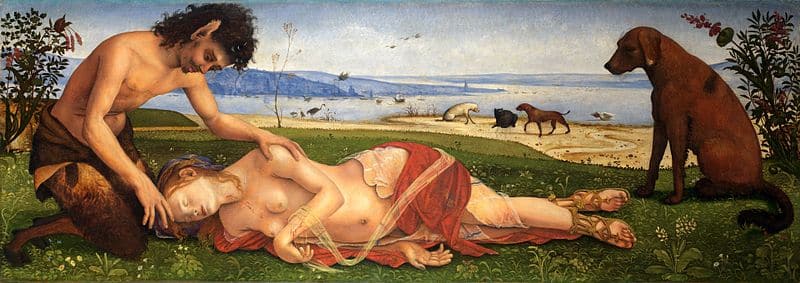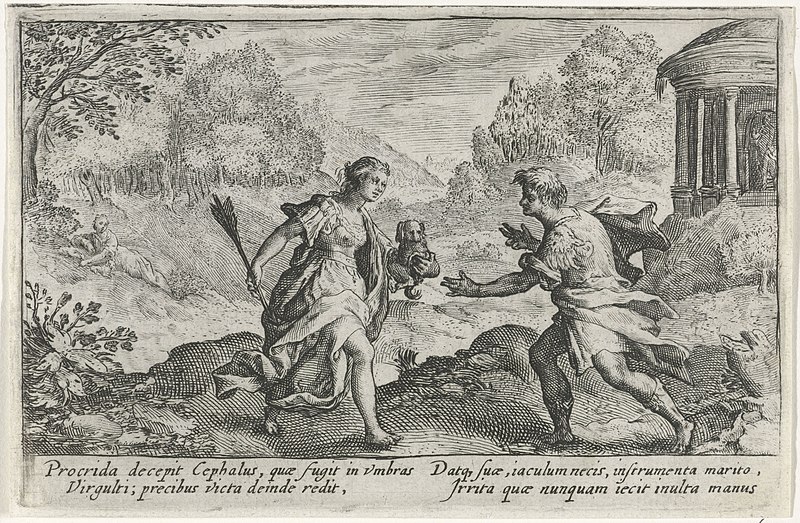In the annals of Greek mythology, where creatures of wonder and terror roam, there’s a hound whose legend is as intriguing as any. Laelaps, the dog fated to catch anything it pursued, stands as a testament to the paradoxes that even the gods grapple with.
Laelaps Key Facts
| Origin | Gifted by Zeus to Europa |
| Creator | Zeus |
| Defeated by | Turned into Canis Major constellation by Zeus |
| Habitat | Various, depending on its master |
| Other names | None |
| Roman name | Not applicable |
| Associated with | The Teumessian Fox, Zeus, Europa, Cephalus |
| Symbols | Pursuit, inevitability, the chase |
Name and Etymology
The name “Laelaps” translates to “Hurricane” or “Stormwind” in ancient Greek, a fitting moniker for a hound whose speed and tenacity were unparalleled. Moreover, this name encapsulates the essence of the dog: relentless, unstoppable, and ever-persistent.
There isn’t a direct Roman counterpart to Laelaps, making its legend predominantly Greek. This absence in Roman tales further emphasizes the unique narrative space the hound occupies in Greek mythology.
The name is not just a title but a descriptor, a testament to the hound’s nature and the legends woven around it.

Laelaps Origin and Creation
The hound was a divine creation, a gift from Zeus to Europa, after he had wooed her in the guise of a bull. This wasn’t just any gift but a hound that was destined to catch any prey it pursued. Moreover, it was a symbol of relentless pursuit and inevitability.
After Europa, the hound came into the possession of King Minos of Crete. However, Minos gave it to Procris, and eventually, it ended up with her husband, Cephalus, The First King of Cephalonia. It was with Cephalus that Laelaps’ most famous hunt would occur, pitting it against the Teumessian Fox, a creature destined never to be caught.
Laelaps’ creation and journey through various masters highlight the intricate web of relationships and destinies in Greek mythology, where gifts, especially those from the gods, often come with challenges and profound implications.
Depiction And Characteristics
Laelaps, in most accounts, is described as a majestic hound, its form radiating strength and agility. While its physical attributes might resemble those of other hunting dogs, it’s the aura of inevitability and relentless pursuit that sets it apart.
In art, it is often depicted mid-chase, muscles taut, eyes focused, embodying the essence of its destiny: to catch whatever it pursues.
Nature and Behavior
Laelaps was not just a hunting dog; it was the embodiment of the chase. Its behavior was not driven by malice but by its very nature, its divine destiny. When set upon a prey, it would pursue relentlessly, a force of nature that nothing could deter.
To the Greeks, Laelaps was a symbol of inevitability. Just as day follows night, if the dog pursued, it would catch its prey. This was not a matter of if but when.
Defining Abilities
Laelaps’ ability was its destined success in hunts. It was fated to catch any creature it pursued, making it an unparalleled hunter in the world of Greek mythology. This trait was not just a testament to its speed and skill but was seen as a divine trait, a destiny set by the gods.
Its prowess was not just in its physical abilities but in the weight of its destiny, making it a formidable creature in both might and myth.
Symbols or Associations
Laelaps is primarily associated with the idea of relentless pursuit and the inevitability of outcomes. Its very existence is a testament to the idea that some outcomes, especially those set by the gods, are inescapable.
In terms of symbols, it’s often represented by images of a hound in mid-chase. Furthermore capturing the essence of its relentless nature and its destined success in hunts.
Myths about Laelaps
Not as central as some figures in Greek mythology, Laelaps however plays a crucial role in the story of him and the Teumessian Fox.
The Paradoxical Chase with the Teumessian Fox
The most iconic tale involving Laelaps is its encounter with the Teumessian Fox. Set upon the fox by its master, Cephalus, the dog found itself in a paradoxical situation. While it was destined to catch any prey it pursued, the Teumessian Fox was fated never to be caught. This set the stage for an eternal chase, a puzzle with no apparent solution.
Recognizing the paradox of their destinies, Zeus intervened. To resolve the unsolvable riddle, he turned both Laelaps and the fox into stone. Next he placed them in the night sky as constellations. They became the constallations we know as Canis Major (Laelaps) and Canis Minor (the fox). This tale serves as a reminder of the challenges posed by conflicting destinies and the divine interventions sometimes needed to address them.
Representations In Art
Laelaps, given its nature and the myths surrounding it, has found its way into various art forms over the ages.
Ancient Greek pottery often depicted the hound, especially in scenes involving its chase with the Teumessian Fox. The tension, the relentless pursuit, is palpable in these artworks, capturing the essence of the hound’s destiny.
In more recent times, sculptures and paintings have sought to capture the spirit of Laelaps. The focus being on its form, its agility, and its relentless nature, making it a symbol of pursuit and inevitability in art.

Mentions in Ancient Texts
Laelaps, while not as frequently mentioned as some creatures, has its place in ancient Greek literature.
Hyginus, in his “Fabulae,” provides a detailed account of Laelaps, its origin, and its fated chase with the Teumessian Fox. A line from this text captures the essence of their chase: “When Laelaps was set upon the Teumessian Fox, a creature destined never to be caught, they were locked in an endless pursuit.”
Apollodorus, in his “Bibliotheca,” touches upon the story of Laelaps, providing another perspective on the hound’s destiny and its implications.
Frequently Asked Questions
Laelaps was destined to catch any creature it pursued, making it an unparalleled hunter.
Recognizing the paradox of their conflicting destinies, Zeus turned both Laelaps and the fox into stone. He later placed them in the night sky as constellations.
The name translates to “Hurricane” or “Stormwind” in ancient Greek.
Notable mentions can be found in the works of Hyginus and Apollodorus.
Zeus gifted him to Europa after wooing her.
Featured Image Credit: Giulio Romano, Public domain, via Wikimedia Commons
